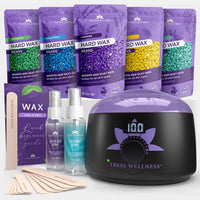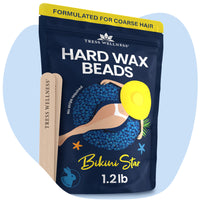Waxing can be a fantastic hair removal option for mature skin, offering long-lasting results and smoother regrowth. However, as skin ages, it becomes thinner, less elastic, and more sensitive, requiring extra care during the waxing process. Whether you’re waxing at home or as a professional esthetician, following the right techniques and using quality products will ensure a comfortable and effective experience.
Understanding Mature Skin and Waxing

Mature skin undergoes natural changes over time, such as reduced collagen and elastin production, making it more prone to bruising or irritation. While waxing can still be a safe and effective method, it’s crucial to take specific precautions to avoid discomfort or skin damage.
The right wax makes all the difference. Hard wax is the ideal choice for mature skin as it adheres to hair rather than the skin, minimizing irritation. Tress Wellness’s hypoallergenic gold wax beads are especially suited for sensitive areas, thanks to their gentle, fragrance-free formula. Pair this with a low-temperature wax warmer to further reduce the risk of burns or sensitivity.
Preparation: The First Step to Success
Prepping the skin properly is key to minimizing pain and ensuring the wax adheres effectively. Hydration is essential—well-moisturized skin is more elastic and less likely to feel irritated during waxing. Start by moisturizing regularly a few days before your session but avoid applying any creams or oils on the day of waxing.
Exfoliation should also be part of your routine. A light scrub 24 to 48 hours before waxing removes dead skin cells, allowing the wax to grip only the hair. Be gentle; mature skin doesn’t respond well to abrasive products. Before applying wax, cleanse the area thoroughly using a pre-wax spray to remove oils, dirt, or bacteria. This creates the ideal surface for waxing and reduces the risk of irritation.
Mastering the Technique: Waxing Mature Skin with Care

To ensure a comfortable and effective waxing session for mature skin, follow these steps for the best results.
Step 1: Test the Wax Temperature
Mature skin is more sensitive to heat, so always test the wax temperature on a small area before application. Use a low-temperature hard wax, like Tress Wellness’s hypoallergenic gold wax beads, to minimize the risk of burns or irritation.
Step 2: Apply Wax in the Right Direction
Using a waxing stick, spread the wax evenly in the direction of hair growth. This helps the wax grip the hair properly and ensures a cleaner removal.
Step 3: Work in Small Sections
Divide the area into smaller sections, especially for delicate or looser skin, like the face, arms, or inner thighs. Smaller sections are easier to manage, reduce discomfort, and allow for more precision.
Step 4: Hold the Skin Taut
Mature skin is less elastic, so holding the skin taut is essential to minimize pulling and prevent bruising. Use one hand to stretch the skin and the other to apply or remove the wax.
Step 5: Remove Wax Swiftly
Once the wax has set but is still pliable, remove it quickly in the opposite direction of hair growth. A fast, confident motion reduces pain and ensures a smooth finish. Avoid hesitating or pulling too slowly, as this can increase discomfort.
Step 6: Clean Any Residual Wax
After finishing a section, clean off any remaining wax using a post-wax spray or an oil-based cleanser. This prevents irritation and ensures the skin feels clean and smooth.
Aftercare: Protecting the Skin Post-Wax

Post-wax care is just as important as the waxing process itself. Soothe the skin immediately after waxing with a post-wax spray or aloe vera gel to reduce redness and irritation. Avoid heat, friction, or anything that might aggravate the skin for at least 24 hours—this includes hot showers, tight clothing, and workouts.
Hydration is a must, both internally and externally. Drink plenty of water and apply a fragrance-free moisturizer regularly to keep the skin supple and soft. If you’re heading outdoors, don’t forget to apply sunscreen to protect freshly waxed areas from UV damage, which mature skin is particularly susceptible to.
Delicate Areas: A Closer Look
Some parts of the body require extra attention when waxing mature skin. The face, for instance, has thinner skin around areas like the eyes and mouth. Use precise waxing sticks for smaller sections, and always hold the skin taut.
For underarms and the bikini area, the skin tends to be more sensitive due to its thinner texture and nerve density. Opt for a gentle wax formula like the Tress Wellness Gold Wax Beads and work in small sections to minimize discomfort. On the legs, where the skin is thicker, be mindful of any varicose veins or bruising. Avoid waxing directly over these areas to prevent irritation or injury.
Why Waxing Works Well for Mature Skin
Despite its delicacy, mature skin benefits greatly from waxing. It provides longer-lasting results compared to shaving, with hair regrowth often becoming finer and sparser over time. Additionally, waxing acts as a natural exfoliator, removing dead skin cells along with hair, leaving the skin smoother and more radiant.
When done correctly, waxing is a safe and effective method for maintaining smooth skin at any age. Using high-quality products, like Tress Wellness’s hypoallergenic wax beads and pre- and post-wax sprays, ensures a gentle, comfortable experience tailored to the unique needs of mature skin.
Final Thoughts
Waxing mature skin may require a bit more attention and care, but the results are well worth it. By focusing on preparation, technique, and aftercare, you can achieve silky-smooth skin without compromising comfort. Whether you’re doing it yourself or visiting a professional, these tips will help you maintain confidence and smoothness at every stage of life.
Smooth skin is timeless—and with the right approach, waxing can help you achieve it effortlessly! 🌟




